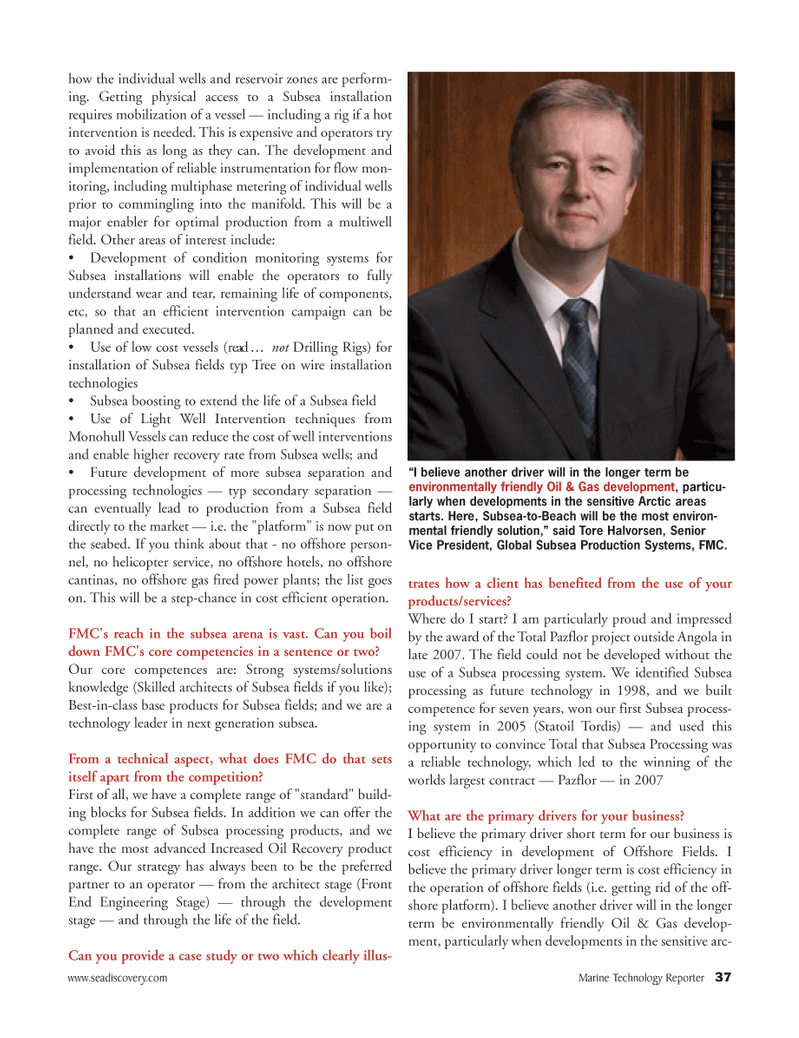
Page 37: of Marine Technology Magazine (April 2005)
Read this page in Pdf, Flash or Html5 edition of April 2005 Marine Technology Magazine
www.seadiscovery.com Marine Technology Reporter 37 how the individual wells and reservoir zones are perform- ing. Getting physical access to a Subsea installation requires mobilization of a vessel — including a rig if a hot intervention is needed. This is expensive and operators try to avoid this as long as they can. The development and implementation of reliable instrumentation for flow mon- itoring, including multiphase metering of individual wells prior to commingling into the manifold. This will be a major enabler for optimal production from a multiwell field. Other areas of interest include: Development of condition monitoring systems for
Subsea installations will enable the operators to fully understand wear and tear, remaining life of components, etc, so that an efficient intervention campaign can be planned and executed. Use of low cost vessels (read … not Drilling Rigs) for installation of Subsea fields typ Tree on wire installation technologies Subsea boosting to extend the life of a Subsea field Use of Light Well Intervention techniques from
Monohull Vessels can reduce the cost of well interventions and enable higher recovery rate from Subsea wells; and Future development of more subsea separation and processing technologies — typ secondary separation — can eventually lead to production from a Subsea field directly to the market — i.e. the "platform" is now put on the seabed. If you think about that - no offshore person- nel, no helicopter service, no offshore hotels, no offshore cantinas, no offshore gas fired power plants; the list goes on. This will be a step-chance in cost efficient operation.
FMC's reach in the subsea arena is vast. Can you boil down FMC's core competencies in a sentence or two?
Our core competences are: Strong systems/solutions knowledge (Skilled architects of Subsea fields if you like);
Best-in-class base products for Subsea fields; and we are a technology leader in next generation subsea.
From a technical aspect, what does FMC do that sets itself apart from the competition?
First of all, we have a complete range of "standard" build- ing blocks for Subsea fields. In addition we can offer the complete range of Subsea processing products, and we have the most advanced Increased Oil Recovery product range. Our strategy has always been to be the preferred partner to an operator — from the architect stage (Front
End Engineering Stage) — through the development stage — and through the life of the field.
Can you provide a case study or two which clearly illus- trates how a client has benefited from the use of your products/services?
Where do I start? I am particularly proud and impressed by the award of the Total Pazflor project outside Angola in late 2007. The field could not be developed without the use of a Subsea processing system. We identified Subsea processing as future technology in 1998, and we built competence for seven years, won our first Subsea process- ing system in 2005 (Statoil Tordis) — and used this opportunity to convince Total that Subsea Processing was a reliable technology, which led to the winning of the worlds largest contract — Pazflor — in 2007
What are the primary drivers for your business?
I believe the primary driver short term for our business is cost efficiency in development of Offshore Fields. I believe the primary driver longer term is cost efficiency in the operation of offshore fields (i.e. getting rid of the off- shore platform). I believe another driver will in the longer term be environmentally friendly Oil & Gas develop- ment, particularly when developments in the sensitive arc- “I believe another driver will in the longer term be environmentally friendly Oil & Gas development, particu- larly when developments in the sensitive Arctic areas starts. Here, Subsea-to-Beach will be the most environ- mental friendly solution,” said Tore Halvorsen, Senior
Vice President, Global Subsea Production Systems, FMC.
MTR#3 (34-49).qxd 4/6/2009 9:07 AM Page 37

 36
36

 38
38
